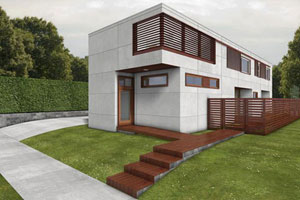Green Home Building
The degradation of the environment compromises not only our survival but also the survival of most living things here on earth. How we build our homes; the materials we use and the design we create can affect the future. Building our home doesn’t seem to affect our planet but it does it ways that we don’t know are harmful for the environment. Due to this, green home building has been created to not only satisfy the people living in it but to make the environment happy as well.
Why Build Green?
 Building green homes will give residents more comfortable homes that cost less to operate, last longer, and keep occupants healthy. Through this you are also given the opportunity to help the environment by creating homes that are efficient, use less resources, and reduce their impact. Green building also helps us save energy, cut greenhouse gas emissions, conserve natural resources, improve air and water quality, and reduce waste.
Building green homes will give residents more comfortable homes that cost less to operate, last longer, and keep occupants healthy. Through this you are also given the opportunity to help the environment by creating homes that are efficient, use less resources, and reduce their impact. Green building also helps us save energy, cut greenhouse gas emissions, conserve natural resources, improve air and water quality, and reduce waste.
A study had shown that if all buildings in the U.S. met leading green building standards, national energy use and global warming emissions would drop by ten percent. Not only that, there is the potential of reducing waste which means a lot as the rate of construction waste recycling at over 70 percent. Managing storm water is also critical in green building; once you have successfully built a green home, you can make your site work like a forest: absorbing water, nurturing trees that clean our air and cool our city, and give kids a place to safely play and explore the natural world.
Just imagine these factors: How much energy is embodied in the building materials, their transportation and assembling? And once the house is built, how much energy does it consume to keep its inhabitants comfortable? The consumption of energy plays a major role in the environment as the pollution it causes result to greenhouse gasses and many other emissions. Not only that, natural beauty is spoilt and lost and the natural balance of the earth is disrupted.
Simple Ways to Build Simple Houses
Building green homes is a process that grows out of a connection with the natural landscape. Decisions are made on the site and materials used so builders may be able to reduce the cost and maintenance as well as reduce the energy usage of the home. Conservation is key in building green homes; the result is a more comfortable, healthy and safe home that costs less to operate.
Things to consider when building a green home:
Passive Solar Design
In all climate conditions, this design is used for natural heating and cooling. It is essential to know the tips on building a solar design depending on the climate of your country. For warm climates, the broad side of the house should be faced to the north or south to avoid excessive heat gain while in cold climates solar heat should be absorbed by concrete or stone to be slowly released in the evening.
Ventilated Attic Spaces
Attic spaces accumulate heat in hot climates which will transfer to the rooms below while moisture can accumulate in unventilated attic spaces in cold climates. The house must have continuous eave and roof vents that will create natural flow through the attic. Good insulation in the attic is essential for comfortable indoor temperature.
Reduced Water Needs
Your home should have rainwater catchment systems. You may use gutters and barrels/drums to catch and store water that falls from the roofs. For home appliances, pick a front loading washing machines and dishwashers that have no heat-drying.
Small AC Systems will do
A smaller system runs long enough to reach desired cool temperature and clear the air of humidity while oversized system will cool too quickly leaving the room clammy. A smaller system also lasts longer and it is of course, cheaper.
Use Recyclable or Recycled Materials
As much as possible use locally produced and easily renewed materials like bamboo, wood, and earth. Also create a space wherein you can recycle household trash.
Use Safe Materials
Biodegradable, non-toxic , and water-based products must be used. Avoid products that contain dyes, ozone depleting chemicals, heavy metals, formaldehyde, or known carcinogens.

